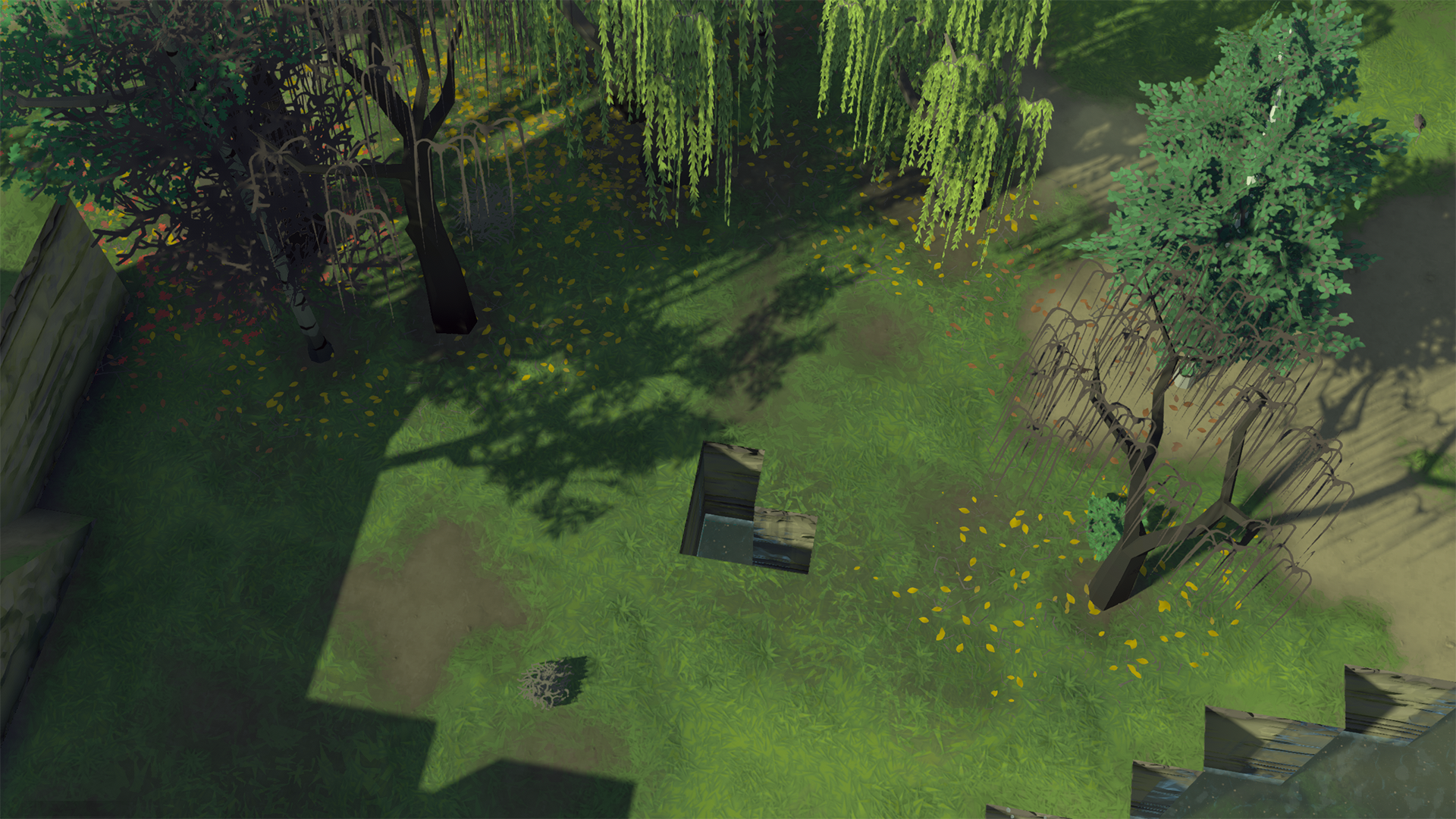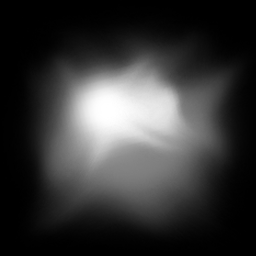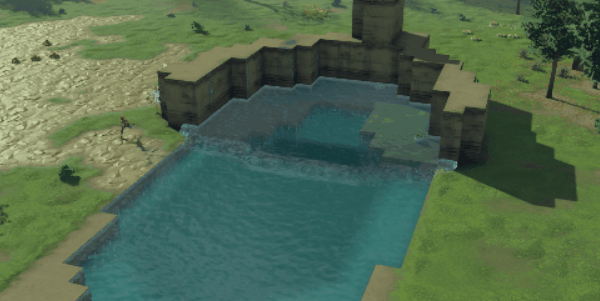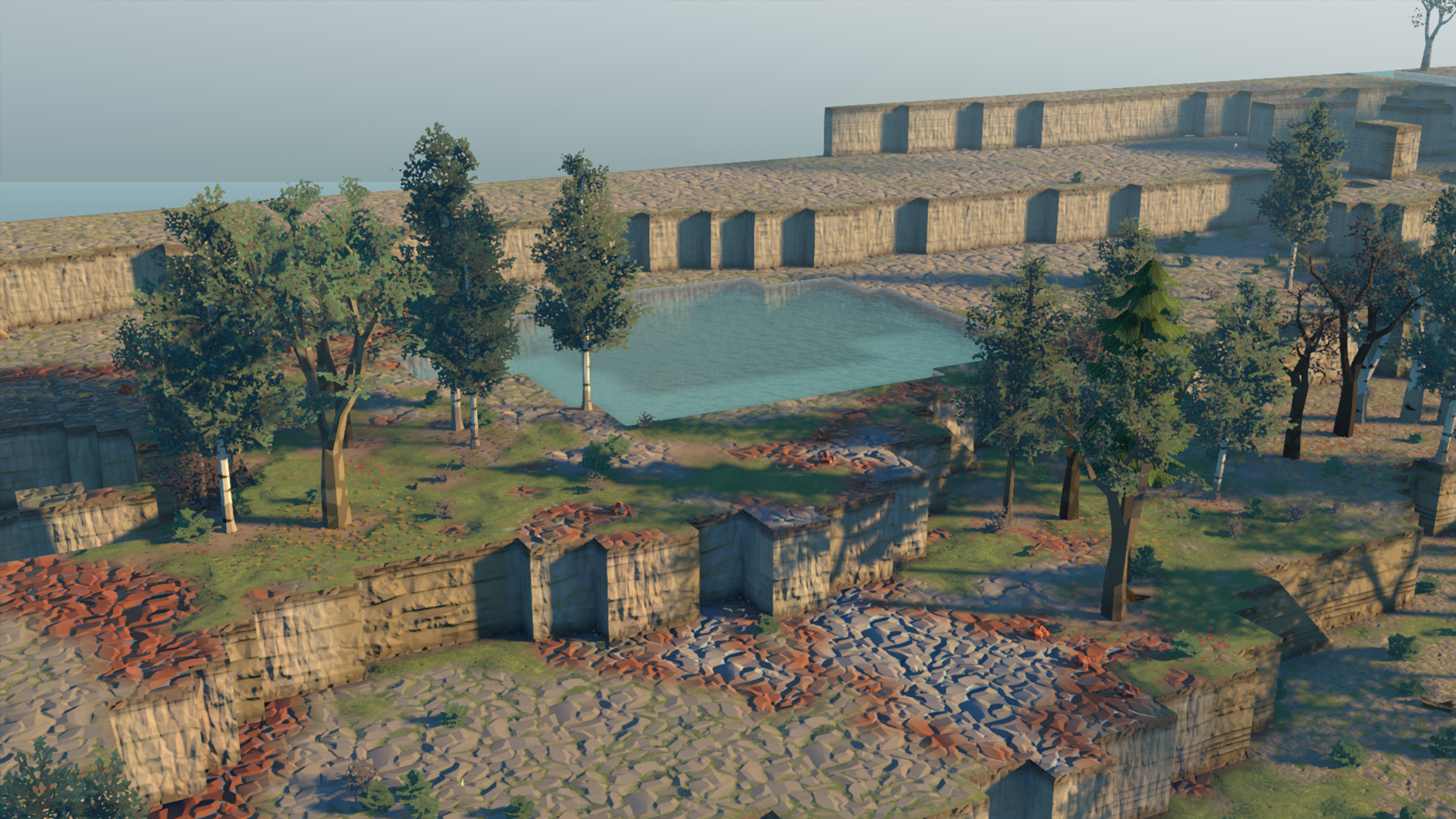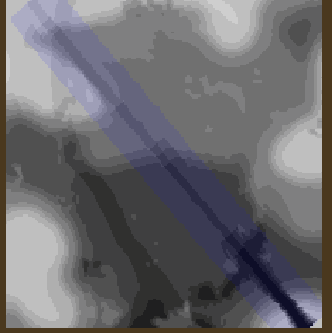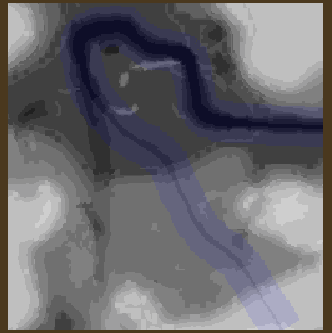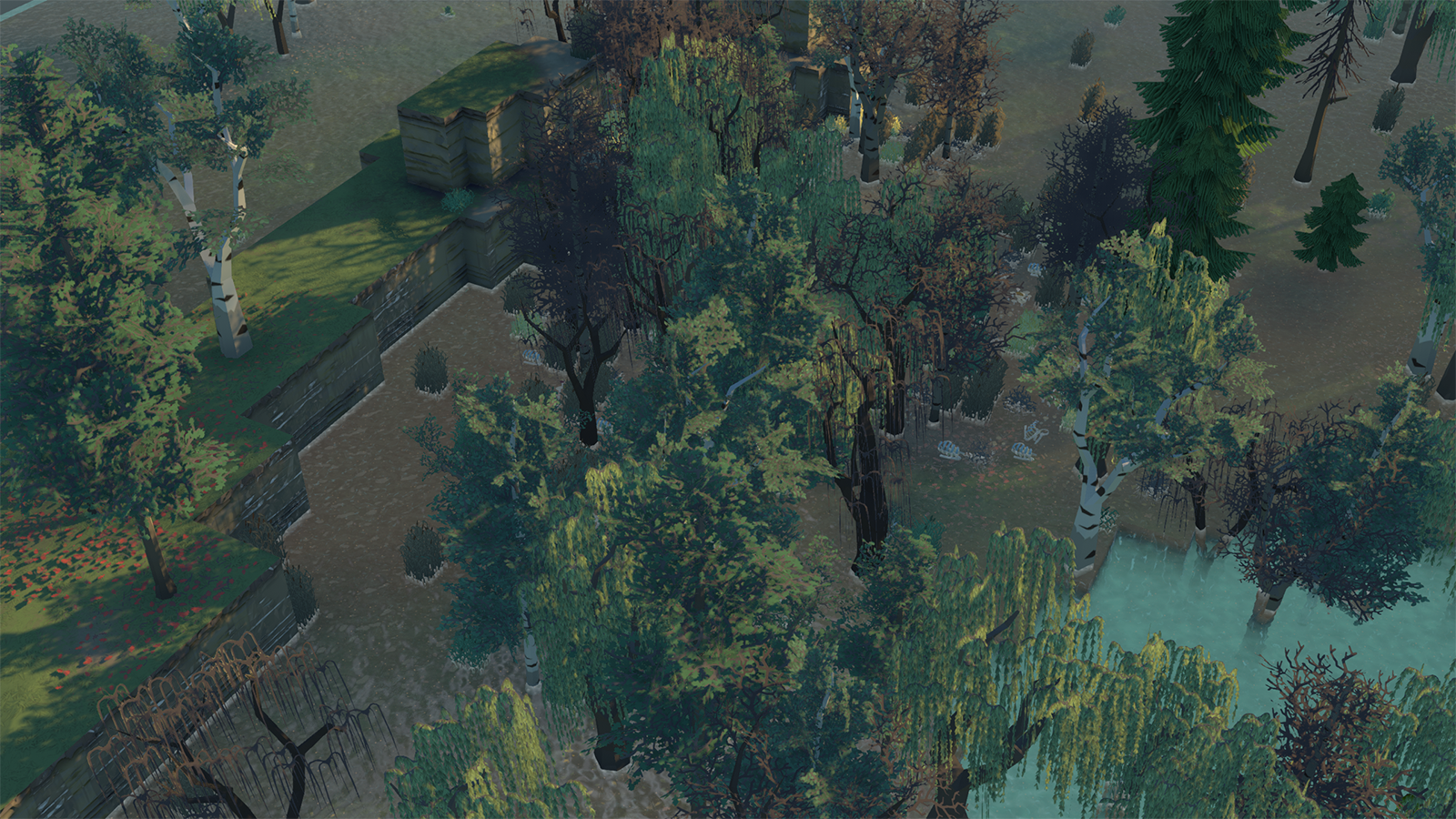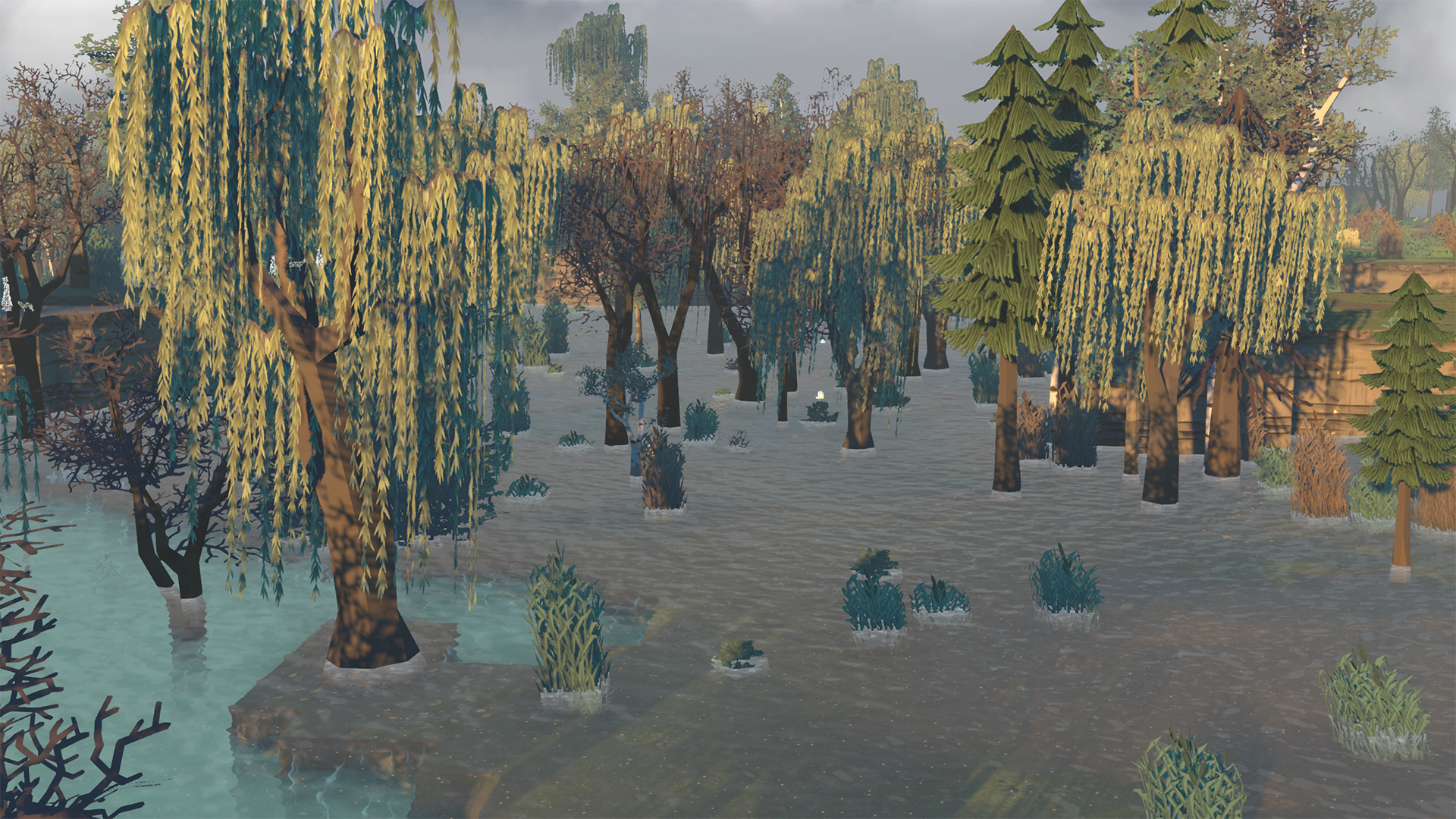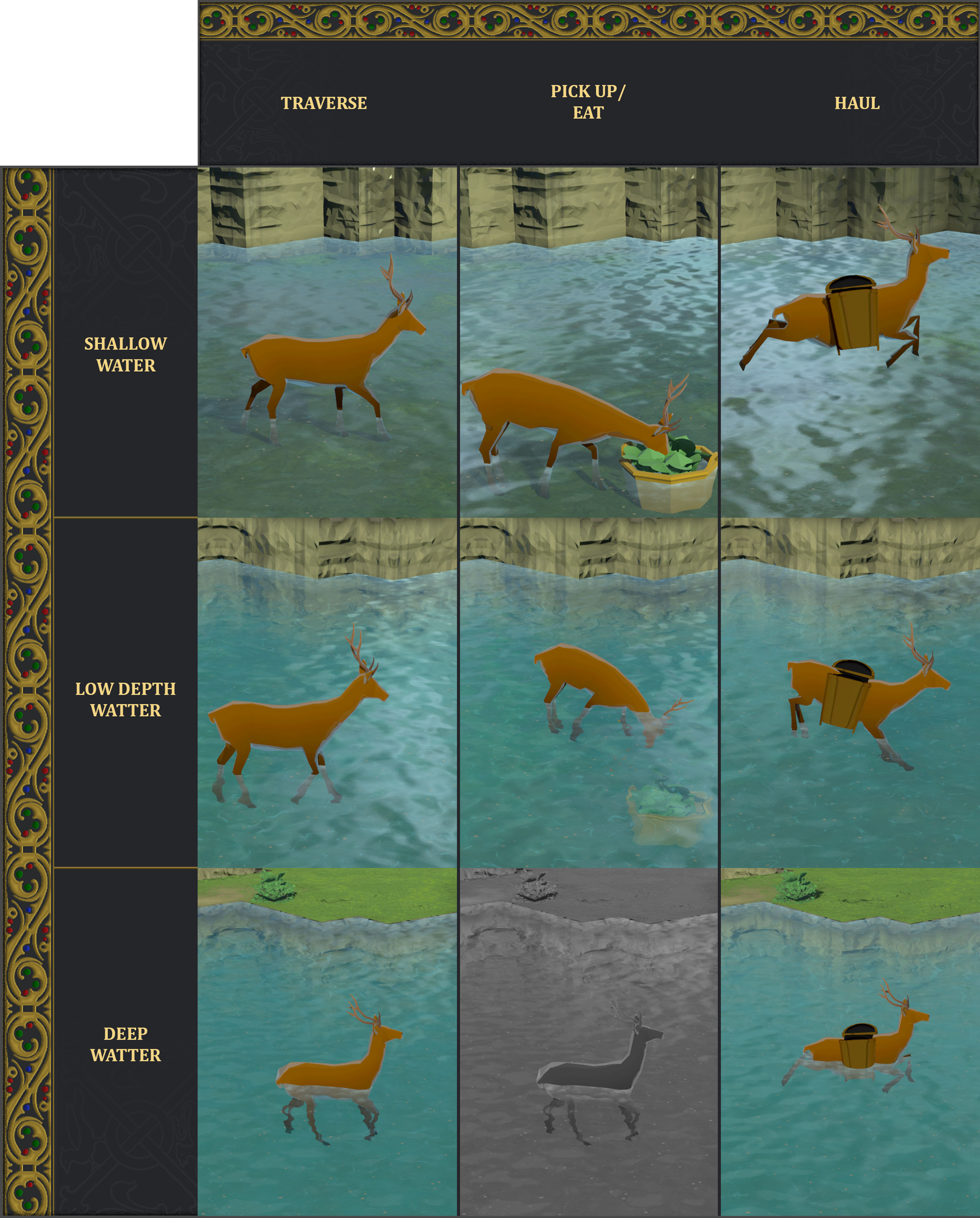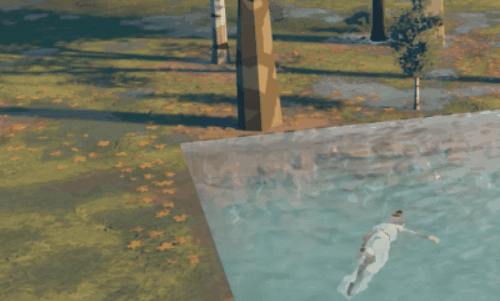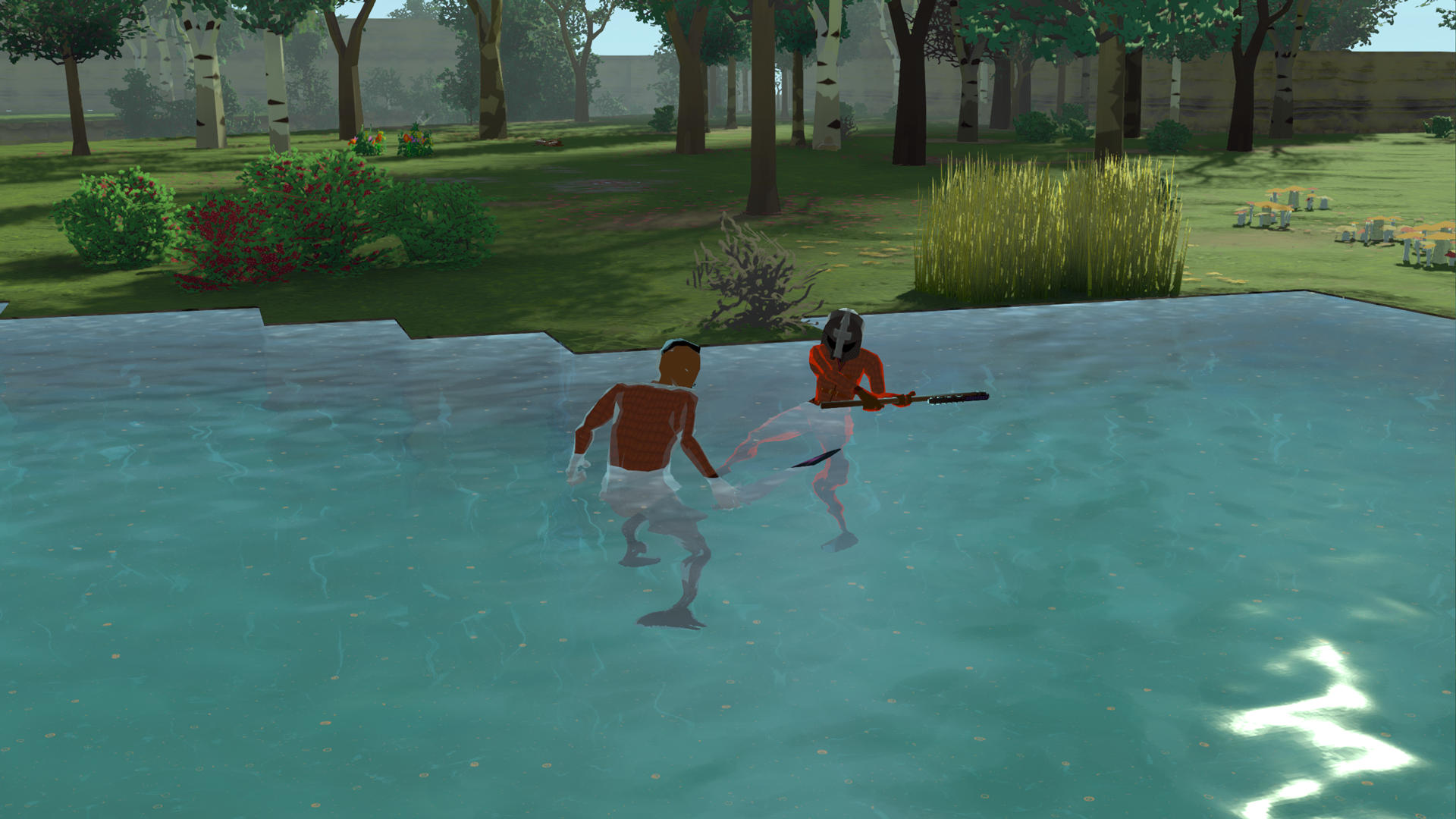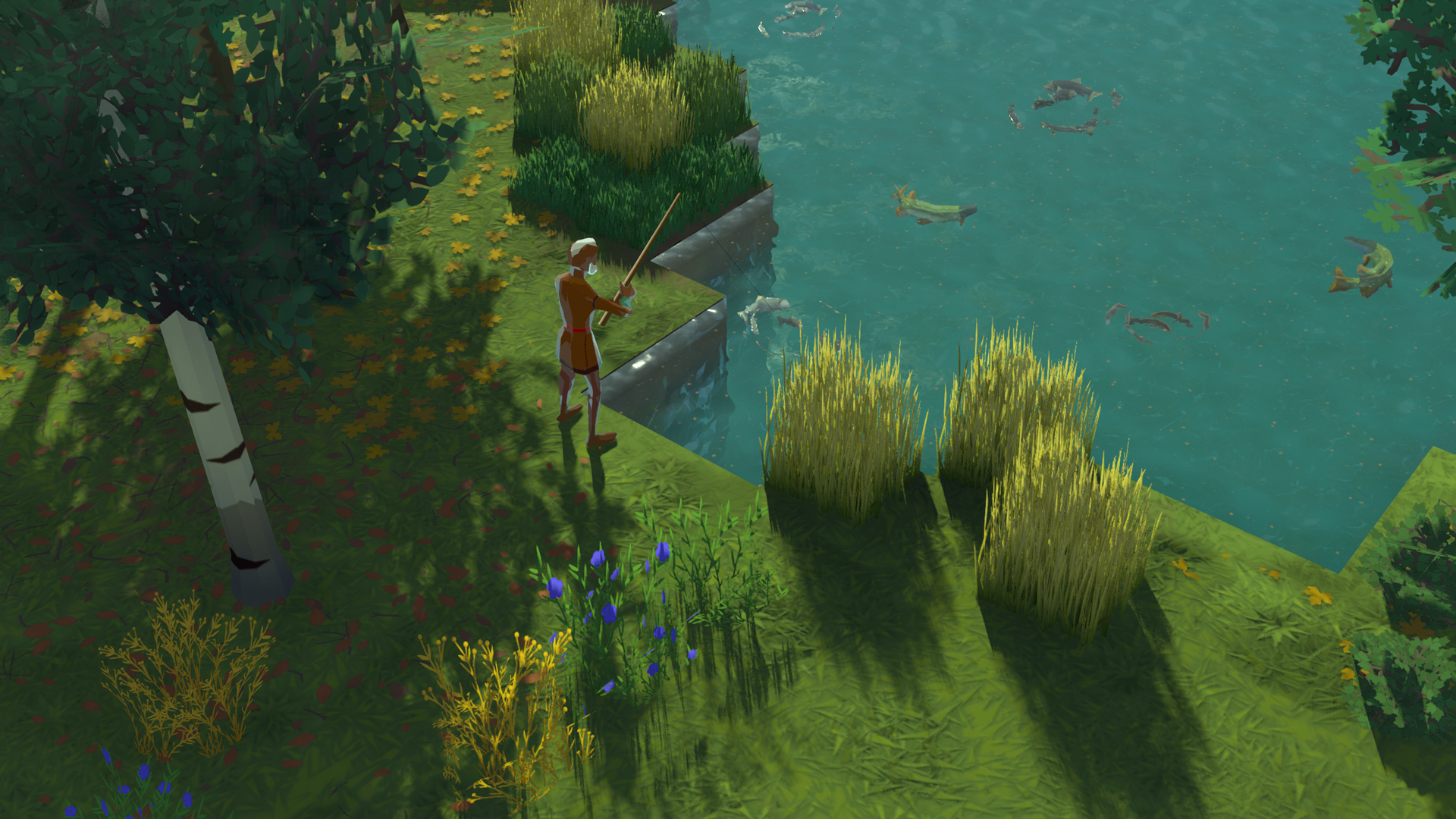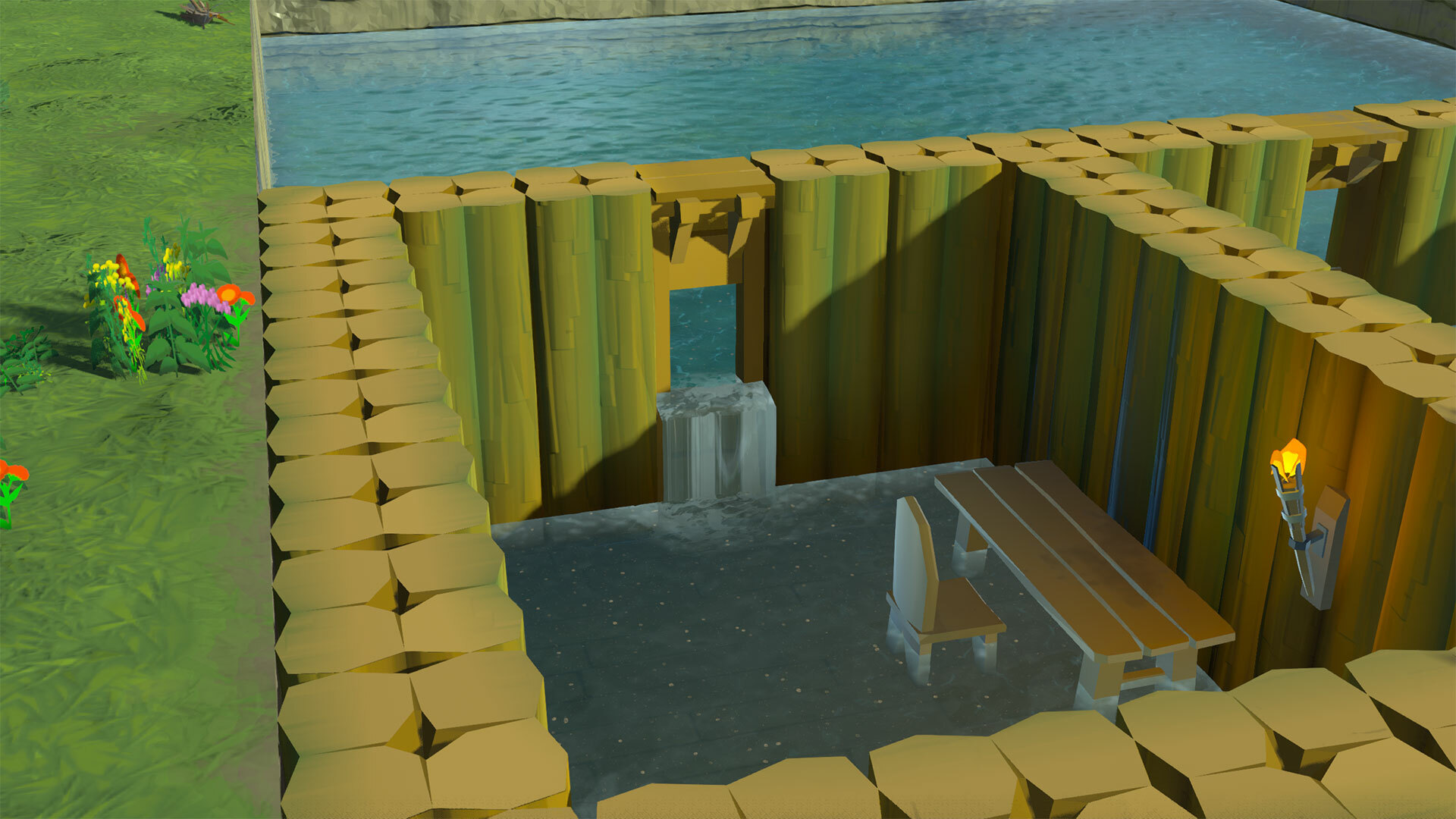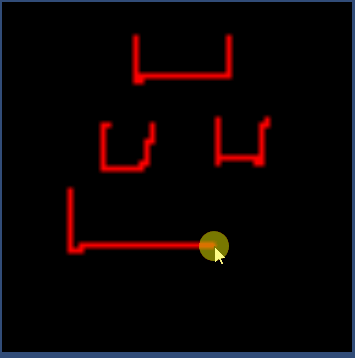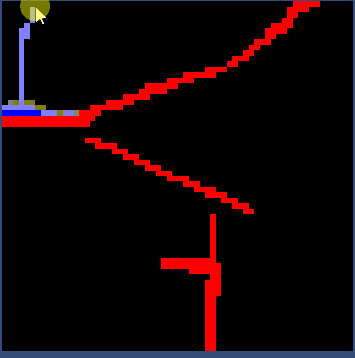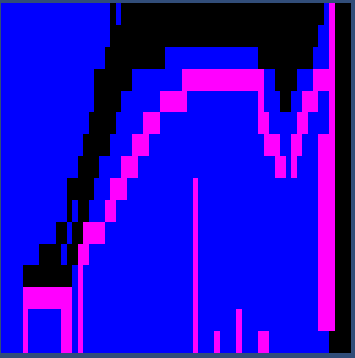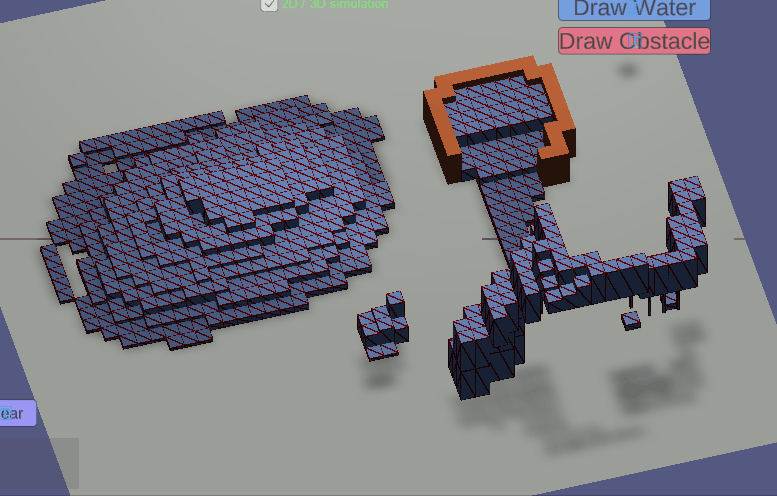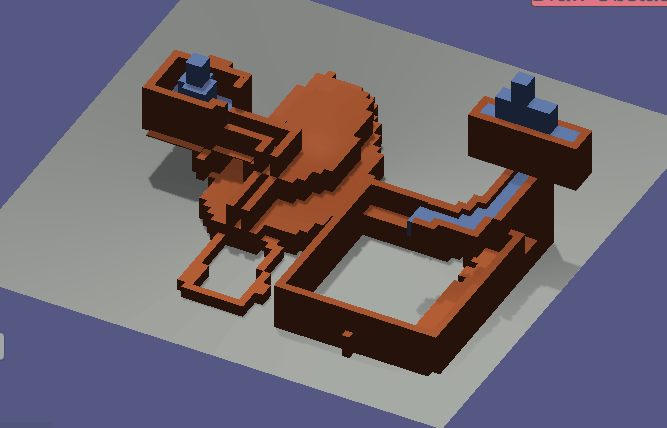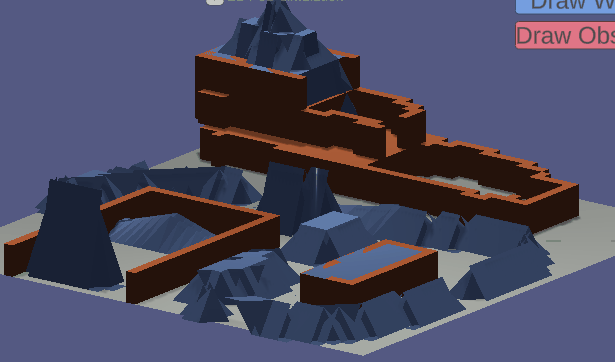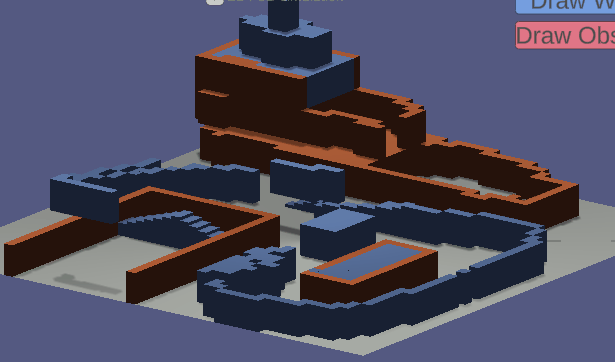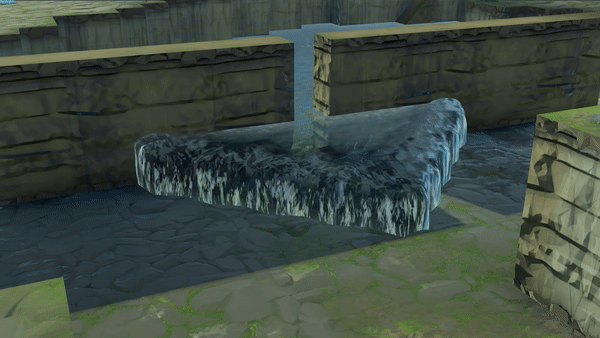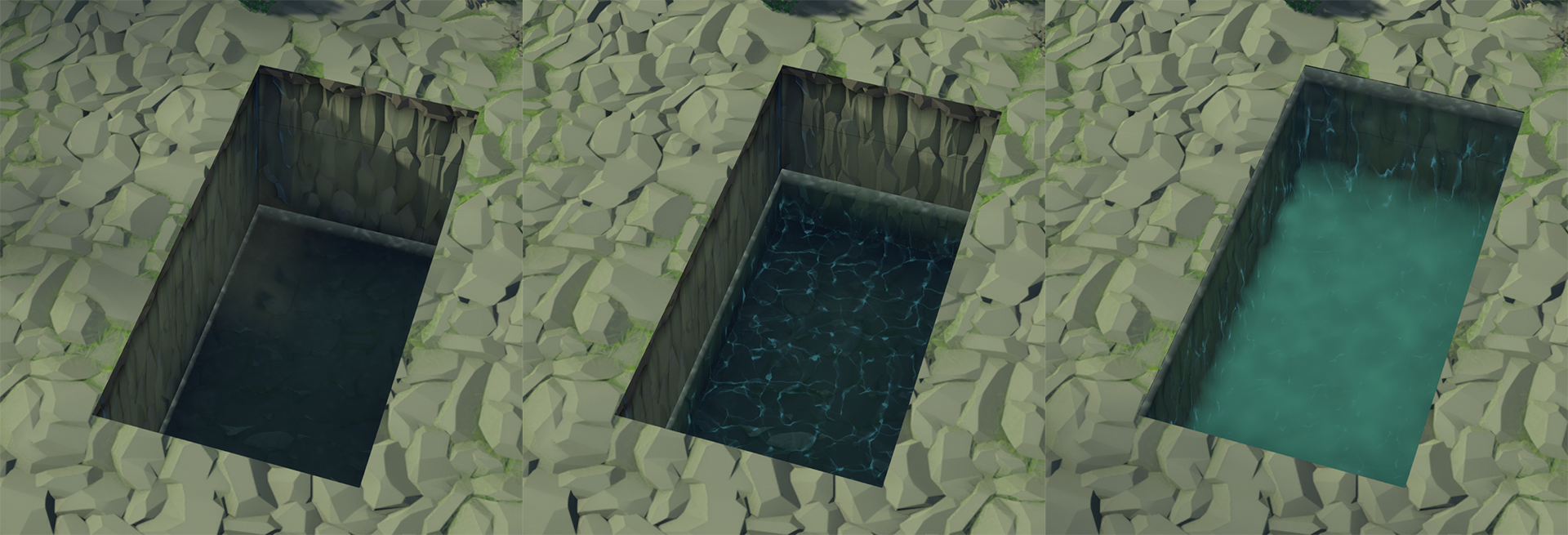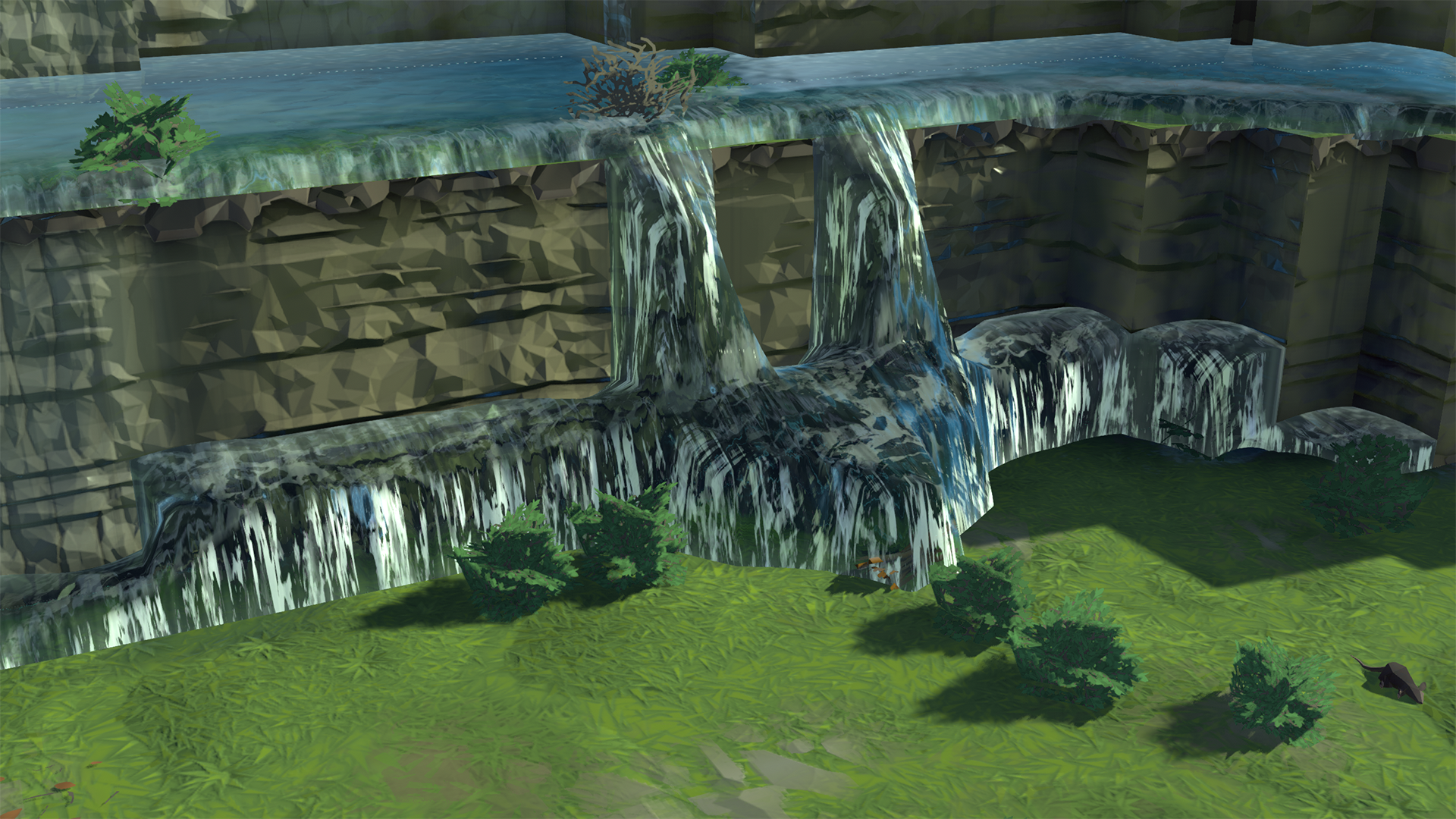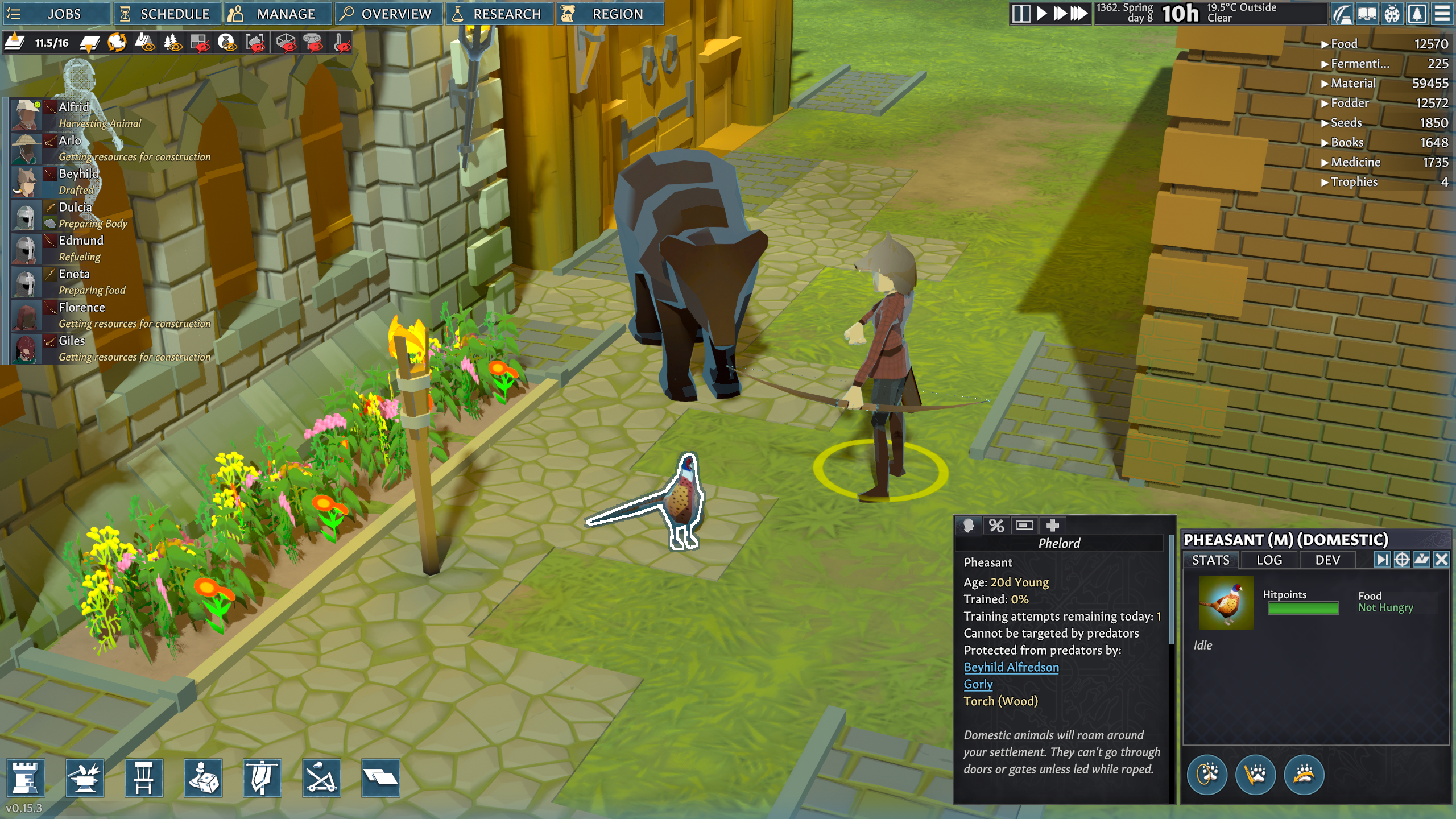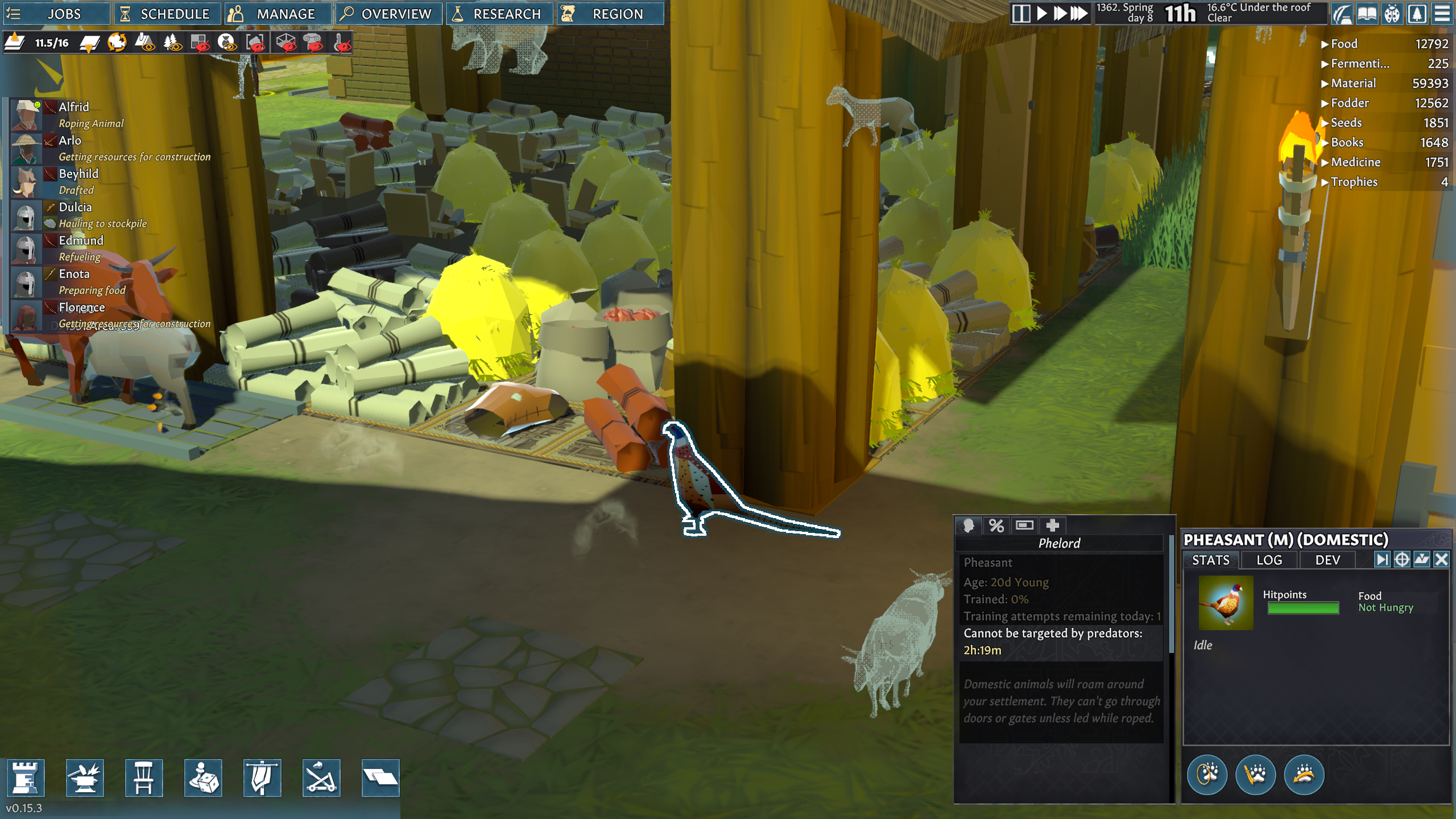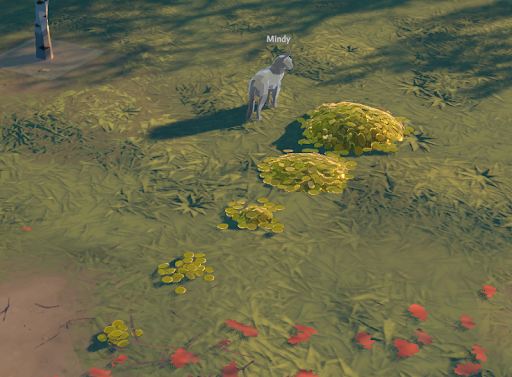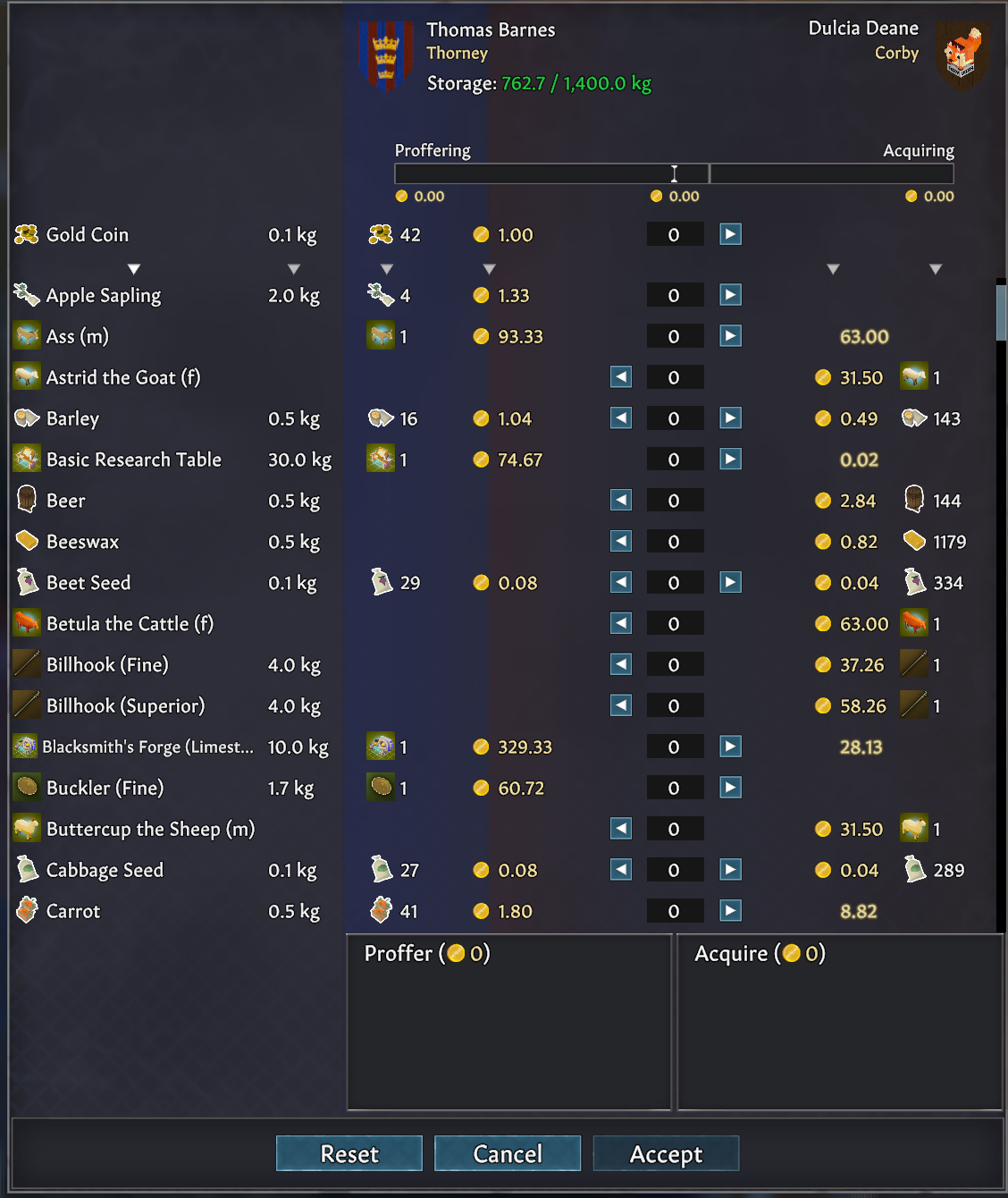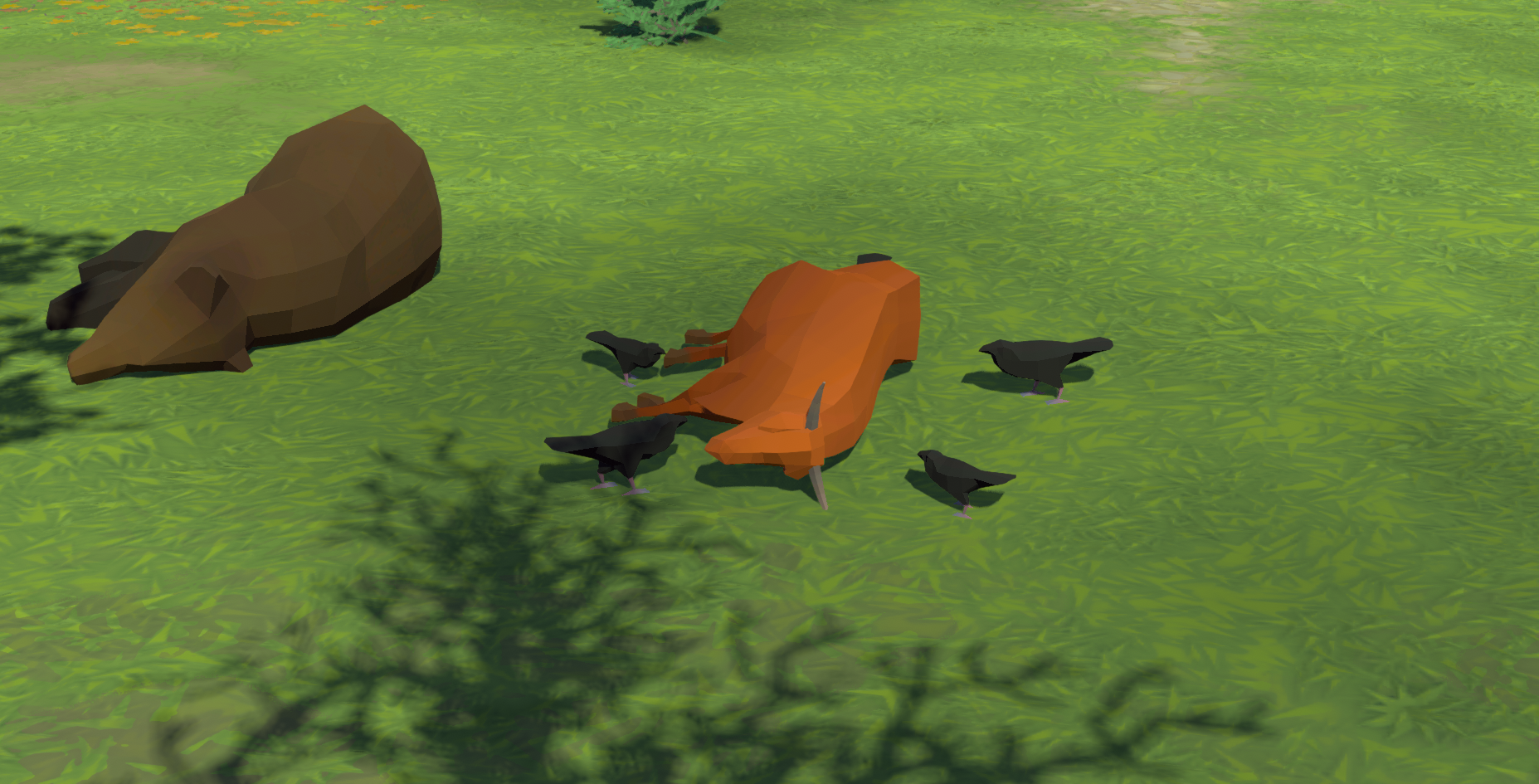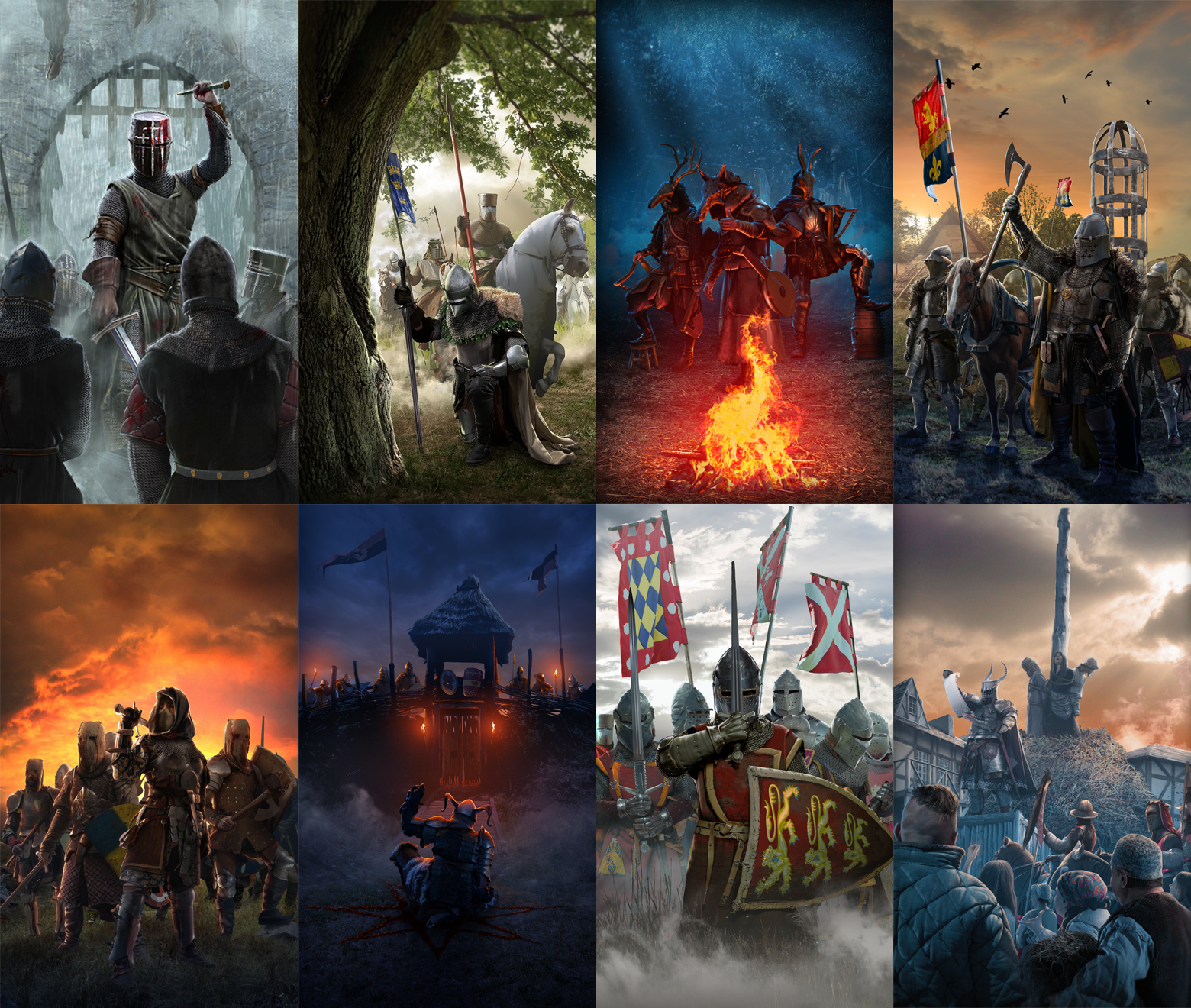
Nov 10, 2023
Going Medieval - SeVerin
Greetings players! The newest patch (0.16.2) is now live on all platforms on the experimental branch. Please save your progress and restart your game client to update. You should be able to load normally and continue playing. Once it is properly tested, we will push it live in the official update! Here are the notes for what awaits you in this version, but first, a warning:
Now, onto the update:
It will move when given the chance, so digging a hole next to a lake or river will make the water go to that empty spot. The way water is simulated is not supposed to be very realistic, but is simplified and follows some basic logic.
Shallow water
DISCLAIMER: We sincerely suggest that you start a new map to properly experience water and terrain adjustments that accompany it. If you have an old save that you really want to add water to, you can find the guide below. If you try to use Dev Tools and report bugs in the process, those reports will be ignored simply because dev tools can be buggy, we can’t cover all of the custom scenarios made by these tools and because the game is not experienced the way it was intended. Since we are a small team, this is made so we can focus on the core experience and prioritize our bug fixing to the real bugs. But we also want for you to have fun, and create fun experiences and screenshots.
To add water to the existing maps, you will need to enable Dev Tools first. This is done on the experimental branch (only on Steam). For it to work, you'll have to change two files:
1) Find your game within steamapps in this location: SteamLibrary\steamapps\common\Going Medieval\Going Medieval_Data\StreamingAssets\Data\ . Find file named GameSettings.json and open it with notepad. Look for the devTools line and change false to true . Save the file.
2) Go here: %userprofile%\appdata\locallow\Foxy Voxel\Going Medieval\ . Find file global.config and open it with notepad. Look for the devtools and change false next to it to true . Save the file.
Now start the game and go to Options > Game > Dev tool.
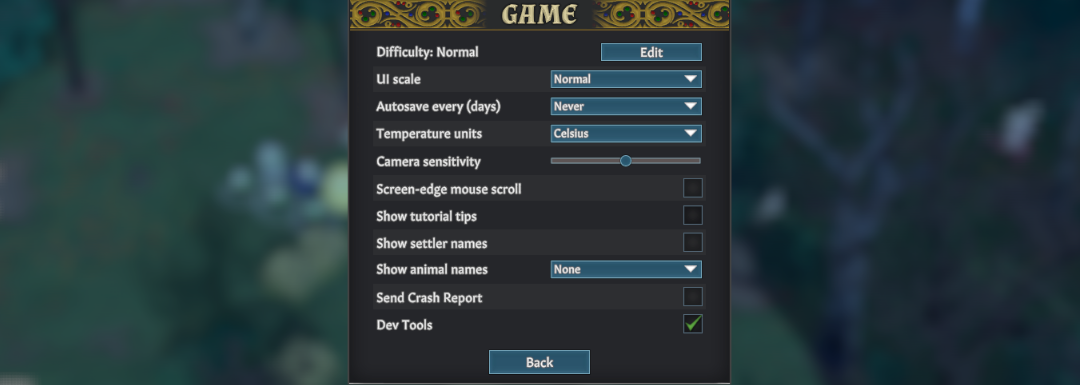
In the upper part of the screen, a new tab titled DEV TOOLS will appear next to the Region tab.

When you select it, a new window will appear showing various commands. Look for the TOGGLE WATER DEBUG UI and select it.
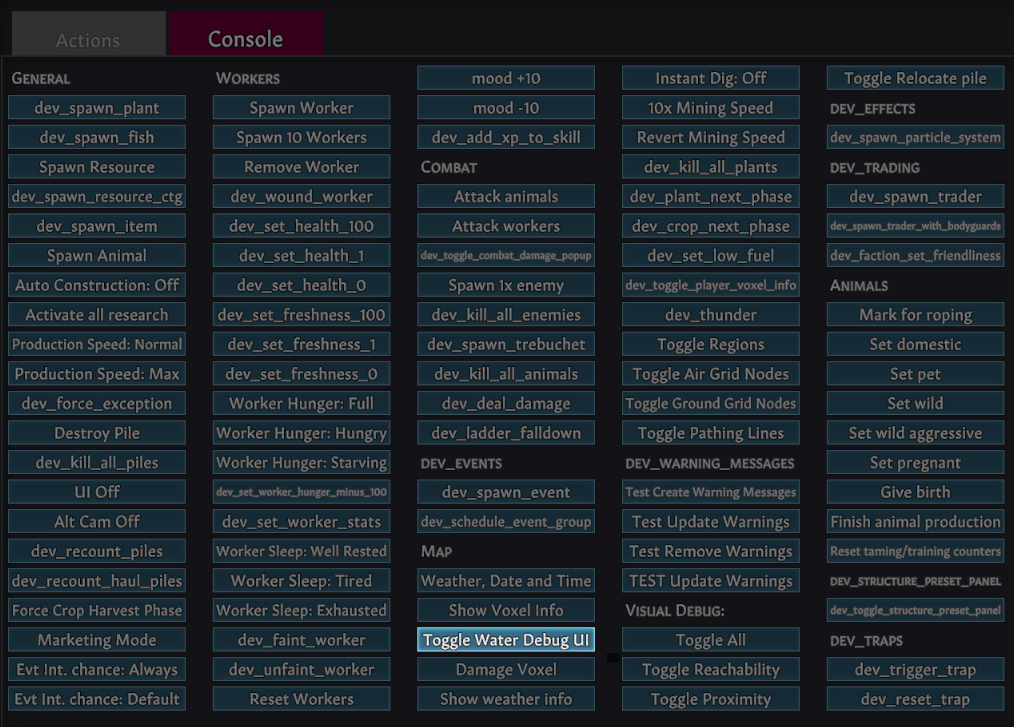
This will add a new window that allows you to add and control water. To use this window, you’ll have to select “Enable Draw/Edit”. We’re going to explain what each function does:

Add water - selecting it will add water to the voxel where your mouse is. You can use the click and hold function to draw water across the area. If the area is flat and the amount of added water is modest, there is a big chance that the water will disappear after some time.
Fill to cursor - will add water depending on the cursor positioning. Be careful when using this as it may overflow the map. Take into consideration the angle of the camera, too.
Add flow in - this will add a voxel that will constantly emit water from its positioning. When you see a map with a river in it, this is the type of voxel located on one edge of the map.
Add flow out - this is the type of voxel located on the other side of the river that ‘swallows’ the water and stops it from overflowing in that case. By default, map edges are surrounded by these voxels.
Water level to set - indicates the amount of water that will be placed on start when using the add water function.
Draw vertical offset - offsets water placement in relation to the cursor.
Refresh All Obstacles, DBG Visualize Obstacles, Hide DBG Obstacles - this doesn’t have practical use as we used it for debugging purposes early on.
Clear water - Removes all water from the map.
Clear inflow - Removes all inflow voxels from the map, even ones that create rivers.
Enable water sim - turning this off will essentially freeze water movements. Trying to add water in this state will create water blurbs that will stand in one place until this option is turned on.
Tick Water Sim - simulates water movement one tick at a time. Can be used when the water sim is turned off or the game is paused.
Backup Water State - use this to save current water positioning.
Restore Water State - if you make a mess with water experimentation, use this to restore water state to your backup point made above,
Clamp Water Levels - turning this off was used for debugging on our side.
Show water mesh - hides/shows water. It doesn’t erase its functionality, just hides the visuals.
If you still can't find Dev Tools after the instruction above: It might be because you have at one point used unofficial modding tools that modified game's files. Since we don't know what they change, we suggest that you to certain folder and file cleanup. Go to Steam Library > Right-click on Going Medieval > Properties > Local Files > Browse.
This should open a new folder and you should delete all of the files located in there. After you do that, go to Steam Library > Right-click on Going Medieval > Properties > Local Files > Verify integrity... Wait for it to finish and start the game. Don't worry, this will not delete your save files, but you'll still have to change again devtool within .json. Find your game within steamapps in this location: SteamLibrary\steamapps\common\Going Medieval\Going Medieval_Data\StreamingAssets\Data\ . Find file named GameSettings.json and open it with notepad. Look for the devTools line and change false to true. Save the file and start the game and see if you can see Dev Tools within the game's options. If the answer is still no, then...
Go here: %userprofile%\appdata\locallow\Foxy Voxel\Going Medieval\ and delete everything there. Note: This will also delete your saves so be sure to back them up somewhere before you do so. Start the game and exit it. Go back to that folder and find file global.config and open it with notepad. Look for the devtools and change false next to it to true. Save the file. Check if you can see dev tools in game now.
If the answer is No, the last thing we can suggest is to reinstall the game. Again, we're sorry that you are experiencing this issue, but using unofficial tools can lead to unexpected problem like these. :(
Use these tools at your own risk, as they are not perfect nor meant to be used for sandbox experience (but we might focus on that once everything is working as intended). And when you are done, don’t forget to turn the dev tools off so you can report proper bugs, if that is your thing. Enjoy!
DISCLAIMERS:
⚠️ We decided to keep Dev version of the game on the experimental branch, and that means that a Dev log with red text will appear from time to time. This will help us get more info from your side when crashes and bug reports occur.
⚠️ Also, at the moment, the experimental and the main branch are very different. You should not play saves from the experimental branch on the main one as it can cause various bugs - please avoid doing this.
As always, use F10 and/or the experimental bug subforum for reporting experimental issues. Thank you!
Foxy Voxel
Disable Mods if you have them
Please note: if you are using unofficial mods you might experience crashes or even an inability to start the game. If you do, turn the mods off before starting the game. If the problem persists, be sure to delete everything in the steamapps\common\Going Medieval and then verify the game files.Now, onto the update:
Water - [Community request]
Water is finally in the game. It will appear on almost every map type as bodies of water like lakes and rivers, as long as a new game is started. There's a chance for a map to not have a river or a lake on it, but that’s because the seed is randomly generated and calculated.It will move when given the chance, so digging a hole next to a lake or river will make the water go to that empty spot. The way water is simulated is not supposed to be very realistic, but is simplified and follows some basic logic.
Levels of water
Water is consistent, meaning that a full voxel of water will spread out on more voxels while lowering its core level. For the gameplay purposes of Going Medieval, water will have 3 levels: Shallow, Low and Deep. This will also make it clear if water can be traversed by foot or is it deep enough to swim. Here are key notes for each level:Shallow water
- About 30cm real world depth (1/10 of the whole voxel).
- Settlers, raiders and animals can walk/run through it (yes, even rats and small animals. We are ok with this. :D).
- Settlers can construct stuff, pickup piles, eat & drink, they can also harvest/slaughter/train animals.
- Production buildings and beds don't work in this depth.
- Leisure activities (praying and backgammon) and furniture are allowed in this depth.
- All plants and trees start to lose HP in this depth except reeds & willow trees.
- Crop Fields can't be placed on this depth except willow trees.
- About 170cm real world depth (around 3/5 of the whole voxel).
- Settlers (regardless of their height), raiders and animals swim in this depth.
- Leisure activities (praying and backgammon) and furniture are not allowed in this depth.
- Settlers can still construct stuff, pickup piles, eat & drink (they will not use chairs in low water).
- Settlers, raiders and animals can’t climb out of low water without ladders or stairs/slopes.
- If there is a floor that above low water, settlers, raiders and animals will swim under it,
- Settlers can’t harvest/slaughter/train animals while the animal is in low water (or deeper).
- Enemies can't attack prod buildings that are in low water.
- Traps will not work on this depth.
- Torches and braziers will not work on this depth, but wall torches will.
- 3m of water (one whole voxel).
- Settlers (regardless of their height), raiders and animals swim in this depth.
- Settlers can still construct stuff, pickup piles, eat & drink.
- Settlers, raiders and animals can climb out of deep water without ladders or stairs/slopes.
- Animals can't eat bushes that are in deep water, can't eat piles or carcasses that are in deep water.
- Enemies can't attack prod buildings that are in deep water.
Water movement
Water will flow if there is available space for it. It can be blocked by the ground, but also some buildings.- Water will flow through open doors, grated doors, wicker doors and barn doors.
- Water can go through grated and wicker floors.
Fishing
- Fish can spawn in rivers and lakes and can be marked by the player to be fished and used as a resource. Fishes spawn logic is similar to plants in a way that they spawn on a location (in this case water) and the settler comes and harvests them.Here is what you need to know about this process:
- Animal handling skill will influence fishing performance.
- Fishing is a part of the hunting job and is performed via order located in the bottom right side of the screen or right clicking on fish after you’ve selected a settler.
- Fish spawns in all bodies of water.
- Fish will die if the water is drained and will drop a small amount of resources in its place.
- You can fish for pike, trout and eel.
- Pike is just one fish and offers a larger chance of failure during the fishing process, but provides more meat if caught.
- Trout flock offers multiple fishes to catch and a smaller chance to fail, but there is not that much meat in the flock.
- Eel is somewhere in-between pike and trout when it comes to chance failure and resource gain.
- Map types can have a different combo of fishes. For instance, marsh maps have more eels and other maps have a combination of trouts and pikes.
- Location in relation to the shore is also influencing what type of fish it spawns.
- Once fished, you can smoke and salt them and turn them into corresponding meals.
Marsh map
What makes a marsh different from other map types (valley, hillside and mountain) is that their terrain will be covered with 50% of shallow water. Here are other notable things you can expect on the Marsh map:- Marsh soil - similar to the regular soil, but leaves shallow water where it is dug out. It appears only on marsh maps and gives only 1x soil instead of 3x like regular dirt voxels.
- Willow trees - similar to regular trees, but mostly present on marshes,
- Reeds - located mostly on marshes. They offer hay, albeit less when compared to tall dry grass.
- Water Vole - similar to a rat. Gives good leather and mostly spawns in marsh map types. Can be held in pens.
- Mallard - medium-sized waterfowl species that spawns on marsh maps. Can be held in pens.
- Metal and limestone are not present on this map type so you’ll have to acquire them via trading.
- Humans and animals can fight on all water levels.
- Piles rot and decompose much much faster if in water (except fish piles, their decay is slowed down in that case).
- Flora doesn’t spawn in water (except willow trees and reeds).
- Reed will start dying if it’s deprived of water.
- If you start a trade with another village located in the marsh map type, expect that the stock of that village will probably lack limestone but will offer more herbs.
Other Notable Stuff
Urgent Haul order
Urgent Haul is a new order type located in the Jobs panel that is separated from the (regular) haul. This will give you more control when it comes to prioritization and which settler will respond to the Urgent Haul order. Here is how it works:- There is a new “Urgent Haul” button located in the lower right corner of the screen.
- Settlers that have only urgent haul on (regular haul off) will only haul urgent marked piles and not the ones that are not marked.
- Settlers that have haul on (urgent haul off) will haul urgent marked piles too, but they will not prioritize them during the hauling process.
- Pets will follow urgent haul orders, too, regardless of their owner’s priorities.
- A pile can't be forbidden and urgent haul marked at the same time.
- A pile that's on a stockpile can't be marked as an urgent haul except if the pile can be moved to a better stockpile.
- Shelved piles cant be marked for urgent haul.
Quality of life changes
- Limestone (impure) is a new type of the voxel we’ve added. It looks exactly like the regular limestone but gives less resources, has less HP and is faster dug. It will be only found on mountain maps. This is so players can dig those maps faster and not have a gazillion limestone around. Don’t worry, ordinary limestone is still present on mountain maps and is the same as before.
- Using the Overview tab now pauses the game.
Bugs and Fixes
- Fixed the bug that indicated that food reserves are low, even when they weren’t.
- Fixed the bug where installing a rug under a bookshelf would cause the books to fall down.
- Fixed the issue that occurred when the settler with a high enough skill (10) to smoke meat returns from a caravan, during which time no other settler could have performed an ongoing order to smoke meat, the smoke house order does not update. It will continue to say no settlers with enough skills are available.
- Fixed the issue where the high motor function would slow down certain activities.
Known issues
- Right clicking and prioritizing fishing is controlled by the cut plant job.
- Animals are lacking in animation when swimming (they’ll appear as walking on water).
- Pathfinding penalty is doing some weird calculations when humans/animals are walking on shallow water and is not working properly.
- Settlers will not choose the closest production building (if there are more of the same type), but the one that has a production set first in the global list of productions.
- If your settlers are experiencing weird animations with some actions, be sure to cap the game's FPS in the game's options. Cap it to 60fps. If the issue persists, cap it at 30. If that doesn’t work, turn the V-sync off.
For players that want to add water on the existing saves/maps
DISCLAIMER: We sincerely suggest that you start a new map to properly experience water and terrain adjustments that accompany it. If you have an old save that you really want to add water to, you can find the guide below. If you try to use Dev Tools and report bugs in the process, those reports will be ignored simply because dev tools can be buggy, we can’t cover all of the custom scenarios made by these tools and because the game is not experienced the way it was intended. Since we are a small team, this is made so we can focus on the core experience and prioritize our bug fixing to the real bugs. But we also want for you to have fun, and create fun experiences and screenshots.
To add water to the existing maps, you will need to enable Dev Tools first. This is done on the experimental branch (only on Steam). For it to work, you'll have to change two files:
1) Find your game within steamapps in this location: SteamLibrary\steamapps\common\Going Medieval\Going Medieval_Data\StreamingAssets\Data\ . Find file named GameSettings.json and open it with notepad. Look for the devTools line and change false to true . Save the file.
2) Go here: %userprofile%\appdata\locallow\Foxy Voxel\Going Medieval\ . Find file global.config and open it with notepad. Look for the devtools and change false next to it to true . Save the file.
Now start the game and go to Options > Game > Dev tool.

In the upper part of the screen, a new tab titled DEV TOOLS will appear next to the Region tab.

When you select it, a new window will appear showing various commands. Look for the TOGGLE WATER DEBUG UI and select it.

This will add a new window that allows you to add and control water. To use this window, you’ll have to select “Enable Draw/Edit”. We’re going to explain what each function does:

Add water - selecting it will add water to the voxel where your mouse is. You can use the click and hold function to draw water across the area. If the area is flat and the amount of added water is modest, there is a big chance that the water will disappear after some time.
Fill to cursor - will add water depending on the cursor positioning. Be careful when using this as it may overflow the map. Take into consideration the angle of the camera, too.
Add flow in - this will add a voxel that will constantly emit water from its positioning. When you see a map with a river in it, this is the type of voxel located on one edge of the map.
Add flow out - this is the type of voxel located on the other side of the river that ‘swallows’ the water and stops it from overflowing in that case. By default, map edges are surrounded by these voxels.
Water level to set - indicates the amount of water that will be placed on start when using the add water function.
Draw vertical offset - offsets water placement in relation to the cursor.
Refresh All Obstacles, DBG Visualize Obstacles, Hide DBG Obstacles - this doesn’t have practical use as we used it for debugging purposes early on.
Clear water - Removes all water from the map.
Clear inflow - Removes all inflow voxels from the map, even ones that create rivers.
Enable water sim - turning this off will essentially freeze water movements. Trying to add water in this state will create water blurbs that will stand in one place until this option is turned on.
Tick Water Sim - simulates water movement one tick at a time. Can be used when the water sim is turned off or the game is paused.
Backup Water State - use this to save current water positioning.
Restore Water State - if you make a mess with water experimentation, use this to restore water state to your backup point made above,
Clamp Water Levels - turning this off was used for debugging on our side.
Show water mesh - hides/shows water. It doesn’t erase its functionality, just hides the visuals.
If you still can't find Dev Tools after the instruction above: It might be because you have at one point used unofficial modding tools that modified game's files. Since we don't know what they change, we suggest that you to certain folder and file cleanup. Go to Steam Library > Right-click on Going Medieval > Properties > Local Files > Browse.
This should open a new folder and you should delete all of the files located in there. After you do that, go to Steam Library > Right-click on Going Medieval > Properties > Local Files > Verify integrity... Wait for it to finish and start the game. Don't worry, this will not delete your save files, but you'll still have to change again devtool within .json. Find your game within steamapps in this location: SteamLibrary\steamapps\common\Going Medieval\Going Medieval_Data\StreamingAssets\Data\ . Find file named GameSettings.json and open it with notepad. Look for the devTools line and change false to true. Save the file and start the game and see if you can see Dev Tools within the game's options. If the answer is still no, then...
Go here: %userprofile%\appdata\locallow\Foxy Voxel\Going Medieval\ and delete everything there. Note: This will also delete your saves so be sure to back them up somewhere before you do so. Start the game and exit it. Go back to that folder and find file global.config and open it with notepad. Look for the devtools and change false next to it to true. Save the file. Check if you can see dev tools in game now.
If the answer is No, the last thing we can suggest is to reinstall the game. Again, we're sorry that you are experiencing this issue, but using unofficial tools can lead to unexpected problem like these. :(
Use these tools at your own risk, as they are not perfect nor meant to be used for sandbox experience (but we might focus on that once everything is working as intended). And when you are done, don’t forget to turn the dev tools off so you can report proper bugs, if that is your thing. Enjoy!
DISCLAIMERS:
⚠️ We decided to keep Dev version of the game on the experimental branch, and that means that a Dev log with red text will appear from time to time. This will help us get more info from your side when crashes and bug reports occur.
⚠️ Also, at the moment, the experimental and the main branch are very different. You should not play saves from the experimental branch on the main one as it can cause various bugs - please avoid doing this.
As always, use F10 and/or the experimental bug subforum for reporting experimental issues. Thank you!
Foxy Voxel





